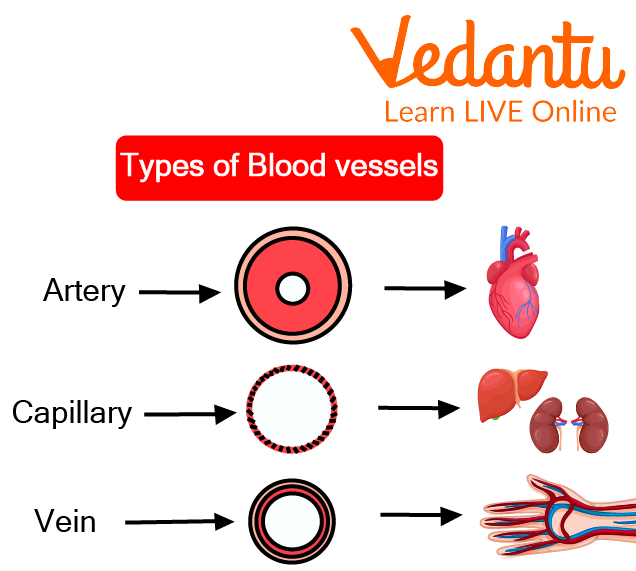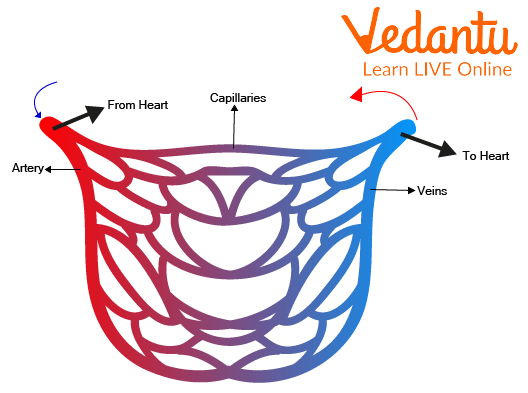




Overview of Blood Vessels in the Human Body
We have observed a red-coloured fluid coming out of our body during any external injury. For example when we accidentally cut our finger with a knife. This fluid is called blood and the tubular structure that carries the blood through tissues and organs is known as blood vessels. You will see images of the tubes of blood vessels and types of blood vessels here in this article.
The cool thing is that the blood continues to flow throughout the body whether you're on your head or jumping on a trampoline with the help of blood vessels. You will also see blood vessel images and capillaries below.
What is a Blood Vessel?
Blood vessels are channels. The channels carry blood throughout our bodies. They form a closed loop that begins and ends at the heart. Our body has about 60,000 miles of blood vessels. This is a tube in which blood circulates. There are different types of blood vessels that we are going to discuss now.
Types of Blood Vessels
There are many types of blood vessels. These are as follows:
Arteries: The body receives oxygen-rich blood from the heart through these robust, present muscles. They don't carry a lot of blood, but they can handle a lot of stress and pressure from the blood flow. Only 10 to 15 per cent of the blood in the body is ever present in the arteries.
Arterioles: Arteries divide into smaller vessels known as arterioles. The flexibility of arteries and arterioles is very high. To support the maintenance of your body's blood pressure, they enlarge or contract.
Capillaries: What are capillaries? The walls of these tiny blood arteries are very thin. Organs and tissues can absorb oxygen and nutrients from the blood via the walls. Additionally, the capillaries remove waste from tissues. Oxygen and nutrients are traded for carbon dioxide and trash in capillaries.
Venules: Veins start as little veins called venules and gradually get bigger as they get closer to the heart. Capillaries deliver blood to venules.
Veins: Despite arteries, veins do not need to transport blood under high pressure, but they do need to transport significant amounts of deoxygenated blood back to the heart. They can manage huge volumes and low-pressure thanks to their thin, less elastic walls. The valves regulate blood flow and maintain a single path of blood flow in your body.

Types of Blood Vessels
Blood Vessels in The Human Body
The heart, which pumps blood throughout your body and maintains circulation, is an important component of this system. All of our body's cells require oxygen to survive, which is transported throughout your body by the blood with the help of blood vessels. Blood vessels in the human body are present throughout the body. They aid in removing waste products and supplying oxygen to cells and organs that are necessary.
Veins, arteries, and capillaries are examples of blood vessels. Our bodies' blood travels through blood arteries, which act as conduits. They create a closed circuit that starts and finishes in our hearts. Blood vessels are often known as tubes or tube blood vessels because they are cylindrical.

Blood Vessel
What are Capillaries?
Your body is filled with tiny blood channels called capillaries. To the cells in your organs and bodily systems, they deliver blood, nutrients, and oxygen. The tiniest blood veins in your circulatory system are called capillaries. The majority of capillaries have a diameter of only 8 to 10 micrometres.
Red blood cells must move through them in a single file since they're so tiny. There are two cell layers seen in capillaries; inside the capillary are endothelial cells. They regulate the movement of gases, nutrients, and liquids. The endothelial cells are encircled by an epithelial layer for protection.
Capillaries can perform a variety of tasks thanks to their three varied shapes:
1. Continuous Fenestrated Capillaries: Small apertures (fenestrae) in continuous fenestrated capillaries allow for quick material exchange. Your kidneys, small intestine, and endocrine glands all contain this type of capillary.
2. Continuous Non-Fenestrated Capillaries: Only tiny molecules can pass through the lining of continuous non-fenestrated capillaries. Along with fat and muscular tissue, the nervous system also has capillaries of this sort.
3. Sinusoidal Capillaries: Small fenestrae in sinusoidal capillaries allow some chemicals to pass through. You have these capillaries in your spleen and liver.

Capillary Blood Vessels
Summary
Your body is made up of an amazing network of blood vessels, which are living tubes used to transfer essential nutrients. Your body contains 60,000 miles (100,000 km) of blood arteries that keep your cells functioning. Your blood vessels would wrap twice around the world if they were all set to end. So blood vessels are very important for our body. Here in this article, we have discussed what blood vessels are, tube blood vessels, and types of blood vessels too. These pieces of information will prove to be really helpful for you. Visit our website to learn more about the human body and related topics.









